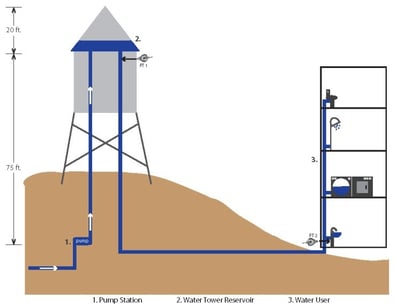
Tank level can be measured in a variety of ways, and each method has its advantages and drawbacks. One of the most common methods for tank level measurements is the hydrostatic method. Hydrostatic pressure is a cost-effective way to measure tank level that doesn’t rely on the measurement being taken directly at the tank, unlike many other methods.
The hydrostatic method uses simple physics to measure tank level. The hydrostatic pressure of a liquid is equal to the height of the liquid above the location of the pressure measurement. The table below demonstrates how certain pressure ranges equal the accuracy of the height measurement.
|
Full Scale Pressure Range |
Tank Level (Water) |
Accuracy of Level Reading |
|
0-1 PSIG
|
0-2.307 feet of water |
+0.07 inches of water |
|
0-10 PSIG
|
0-23.07 feet of water |
+0.69 inches of water |
|
0-50 PSIG
|
0-115.3 feet of water |
+3.46 inches of water |
|
0-100 PSIG
|
0-230.7 feet of water |
+6.92 inches of water |
This height of a liquid can be combined with the known dimensions of the tank to derive a volume of liquid. Different liquids have different conversions based on their specific gravity. The above table is specific to water as a liquid.
To learn more about tank level measurement, click here.
Setra Can Help
To measure the pressure in a hydrostatic tank, it is best to use a pressure transducer. The Model 256 is a rugged and reliable sensor, built for a wide variety of gauge pressure ranges. The Model 231 is a multi-configurable, wet-to-wet differential pressure transducer with field selectable pressure ranges and analog outputs. The Model AXD is designed for high performance, reliability, and versatility in industrial applications like tank level.



